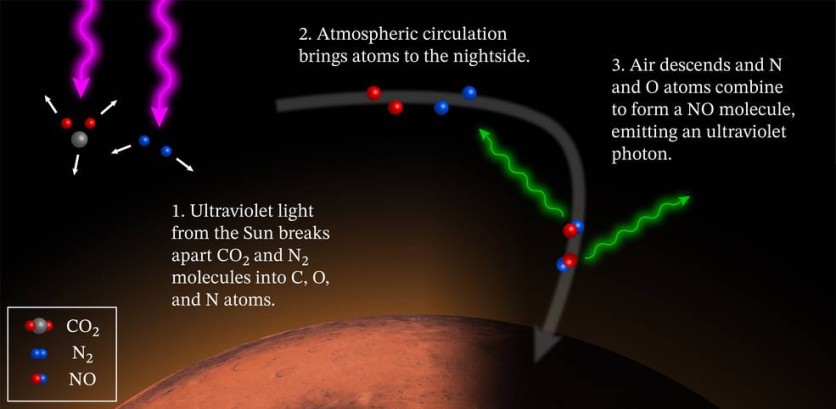Mars is known as the Red Planet. However, NASA recently saw it turned green at night.
According to Daily Mail, this strange phenomenon cannot be seen with human eyes, but with ultraviolet light. NASA captured the images through the Mars Atmosphere and Volatile Evolution (MAVEN) orbiter, and these could help scientists to depict the extremely complex air system on Mars as well as how the light changes with the season.

The study led by Professor Nick Schneider found that few surprises from Mars despite being the second most researched planet, following the Earth. Schneider said the Martian atmosphere is "complicated and insightful" like that of Earth's, including how the light changes as the season shifts.
According to the University of Colorado Dr. Zachariah Milby and study co-author, the green nightglow appears when air currents in the atmosphere plunge to about 40 miles above the regolith or soil on Mars.
Meanwhile, the BBC has reported a green glow that was seen in Mars' atmosphere. While scientists already predicted it to occur on other planets, the European-Russian satellite at Mars Trace Gas Orbiter is the first to have spotted the Martian aura.
What causes Mars to glow at night?
Every night, Mars' upper atmosphere glows in ultraviolet light as the sun sets and temperatures fall to at least -79.6 degrees Fahrenheit. This can be explained by the combination of nitrogen and oxygen atoms to form nitric oxide molecules, which produces small bursts of ultraviolet light.
Dr. Milby simplified the process defined in the study published in the Journal of Geophysical Research. He said that when the atmosphere drops, Mars glows. Like the Earth, the Martian nightglow shifts with the seasons. It appears to be brightest at the peak of northern and southern winters when hotter currents move away from the equator and toward the Martian poles.

Dr. Milby noted that they spent weeks wondering if "there was a bug in our code" that results in the aura. They also found a vibrant spot that flickers at almost exactly above 0 degrees longitude and 0 degrees latitude on Mars. While the researchers still could not explain what causes such vivid glimmer, they suppose it may be due to the underneath terrain's structure.

The planet's green nightglow was initially spotted by the European Space Agency's Mars Express Mission in 2003. It is similar to those observed on Earth and Venus, but it has only been meticulously analyzed recently when MAVEN came along in 2014.
Designed and built-in Schneider's lab, MAVEN's Imaging Ultraviolet Spectrograph (IUVS) instrument scanned Mars from a distance of 3,700 miles. It allows astronomers to take a full picture of the planet five times daily while it rotates.
The first crewed missions to Mars
Dr. Milby said the finding will help the first crewed missions to Mars expected to leave in about 2030. He noted that NASA needs to know specific details about the Martian atmosphere before sending humans to the red planet.
The crewed Martian missions will also require better forecasts to avoid wild winds and storms. Schneider said the observations can help scientists improve their computer models about the planet's atmospheres as well as provide a new perspective to understand the vertical winds and seasonal changes. Thus, they could come up with more accurate forecasts.
Moreover, Schneider said that they can tweak the supercomputers used to predict weather on Earth for observing Mars and other planets.
ⓒ 2026 TECHTIMES.com All rights reserved. Do not reproduce without permission.




